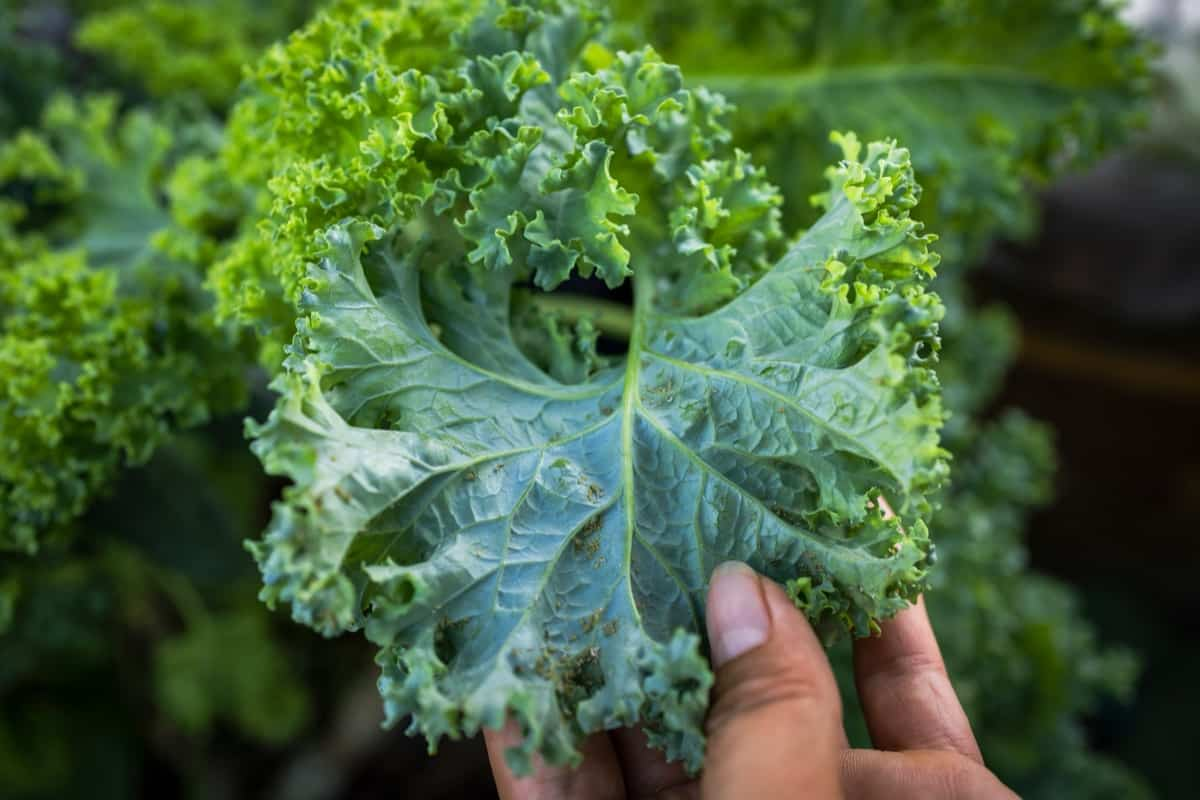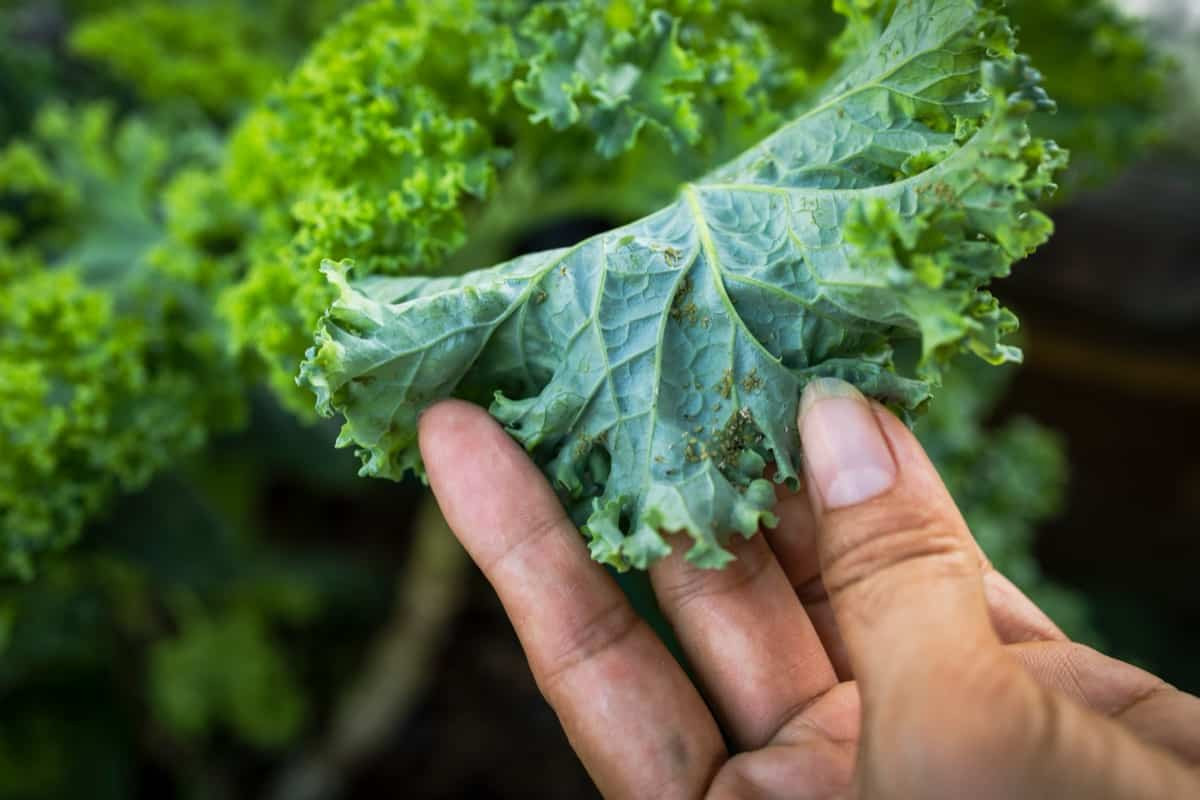Kale is a nutritious and versatile vegetable many enjoy adding to their meals. However, like any plant, it can fall victim to pests that can damage or destroy the crop. Regularly inspecting your Kale plants is crucial for detecting potential pest problems early. Check the Kale leaves for signs of damage or pests.

How to Control Kale Pests Naturally
Understanding Kale Pests: Identifying Common Culprits and Their Damage
- Aphids – One common pest that affects Kale is aphids. Aphids multiply quickly and can infest an entire Kale patch if left unchecked. Identifying Kale pests is essential for maintaining a healthy crop.
- Cabbage worm or caterpillar – The larvae feed voraciously on Kale leaves, leaving unsightly holes that ruin the appearance and weaken the plant’s overall vigor.
- Flea beetles – Flea beetles are known for their ability to chew small holes in young Kale seedlings’ foliage. This damage hampers photosynthesis and makes your plants more susceptible to diseases.
- Slugs and snails – Slugs and snails also threaten your precious greens as they feast upon them during damp conditions, leaving slime trails behind as evidence of their presence.
Soil Management Strategies for Reducing Kale Pest Populations
By creating a healthy and balanced soil environment, we can reduce the likelihood of pest infestations and promote the overall health of our Kale plants. It’s important to ensure that your soil is well-drained. Excess moisture can create favorable conditions for pests such as slugs and snails, so properly amend your soil with organic matter. Practicing crop rotation is crucial in reducing pest populations.
Creating a Pest-Resistant Environment for Kales: Tips and Techniques
By alternating the location of your Kale plants each year, you disrupt the life cycle of many common pests. This makes it more difficult for them to establish themselves in your garden. Crowded conditions can encourage pest infestations by providing ample hiding places and limiting airflow. Mulching around the plant base can also deter pests. Organic mulch acts as a barrier against crawling insects such as slugs or snails.
Companion Planting for Natural Pest Control in Kale Gardens
- Nasturtiums – These vibrant flowers not only add beauty to the garden, but they also act as a natural pest deterrent.
- Dill – It attracts beneficial insects like ladybugs and lacewings, natural predators of aphids and other harmful pests. You can reduce the pest population without using chemical pesticides by attracting these helpful insects to your garden.
- Marigolds – Their strong scent repels many insect pests, including nematodes and whiteflies. Marigolds attract hoverflies, which feed on aphids and other soft-bodied insects.
In case you missed it: 10 Best Plants That Keep Pests Away: A Natural Way of Controlling Pests

Introducing Beneficial Insects to Combat Kale Pests
Ladybugs are one of the most well-known and beloved beneficial insects. These colorful beetles feast on aphids notorious for attacking Kale plants. You can naturally control Kale pests and protect your precious Kale leaves by introducing ladybugs into your garden. Another helpful insect is the lacewing. With its delicate wings and voracious appetite for soft-bodied insects like caterpillars and aphids, this little predator can make a big difference in keeping your Kale pest-free.
Homemade Organic Sprays for Controlling Kale Pests
- Garlic spray – To make this potent concoction, blend a few garlic cloves with water and strain the mixture into a spray bottle. Garlic’s strong odor works wonders in deterring common Kale pests like aphids and caterpillars.
- Neem oil spray – Neem oil acts as an insecticide and fungicide, making it ideal for tackling multiple pest problems. Mix neem oil with water and add dish soap to help the solution observe the leaves.
- Soapy water spray – All you need is a teaspoon of liquid soap mixed with one liter of warm water. Spray this solution directly onto affected leaves to suffocate soft-bodied pests like aphids or spider mites. These are the best organic pest control methods for Kale.
Using Physical Barriers to Protect Kales from Pests
The main method is to use lightweight fabric or mesh row covers. These covers allow sunlight, air, and water to reach the plants while keeping pests out. Secure the edges of the row cover tightly to the ground so that no gaps are left for intruders. Another method is to build a fence around your Kale garden using chicken wire or hardware cloth. This will keep larger pests like rabbits and deer at bay. Ensure the fence is tall enough so animals cannot jump over it or squeeze through any openings.
Natural Predators of Kale Pests: Encouraging Wildlife in the Garden
Attracting beneficial insects like ladybugs, lacewings, and hoverflies can help control aphids and other soft-bodied pests that commonly infest Kale. These insects feed on the pests, keeping their numbers under control. Planting flowers like marigolds or daisies alongside your Kale can attract these helpful bugs. Birds are also great allies in controlling Kale pests naturally. Sparrows, chickadees, and finches love to feast on caterpillars and other small insect pests that target Kale leaves. Providing birdhouses or bird feeders will entice them into your garden.
Monitoring and Early Detection: Key Steps in Managing Kale Pests Naturally
Regularly inspecting your plants can catch pest infestations before they become widespread and do significant damage. Start by checking the leaves of your Kale plants for any signs of chewing or discoloration. If you observe any suspicious activity, take immediate action. Remove affected leaves or plants to get rid of Kale pests. Implementing traps around your Kale garden is another effective method for early detection. Yellow sticky traps attract flying insects such as aphids and whiteflies, while slug traps baited with beer can capture slugs and snails.
In case you missed it: How to Control Greenhouse Pests Naturally: How to Get Rid of Them With Natural and Organic Treatment

Frequently Asked Questions About Controlling Kale Pests Naturally
What is the Best Natural Pesticide for Kale?
If you’re looking for a natural way to control Kale pests, neem oil is the best option. When sprayed on Kale leaves, neem oil creates a protective barrier that repels common pests such as aphids, cabbage worms, and whiteflies. It also disrupts their life cycle by inhibiting their ability to molt or reproduce.
How Do I Keep Aphids Off My Kale?
Aphids can be a frustrating pest, but you can try several natural methods to keep them away from Kale plants. Consider using companion planting as a preventive measure. Planting aromatic herbs like mint, dill, or cilantro near your Kale can deter aphids. These strong-smelling plants confuse and repel the pests.
How to Protect Kale from Pests?
The main approach is to create a pest-resistant environment for your Kale. Companion planting is another great technique for natural pest control in Kale gardens.
What Can You Put on Kale to Keep Pests Away?
Organic sprays are the best way to keep Kale pests away and are made from common household ingredients like garlic, onion, or chili pepper. These sprays act as a deterrent for many pests, making your Kale less appetizing to them.
What is Eating Holes in My Kale Leaves?
Slugs and snails have been known to feast on Kale, eating holes in Kale leaves. Other potential offenders include caterpillars, such as cabbage worms or diamondback moths, which can chomp away at Kale foliage.
What are the Tips for Protecting Kale from Pests?
Start by ensuring that your Kale plants are well-nourished and properly watered. Healthy Kale plants are more resistant to pests and can better withstand attacks. Take the time to closely examine your Kale leaves for any signs of pest activity. If you spot any damaged or infested leaves, remove them immediately to prevent further spread of pests.
What are the Home Remedies for Bugs on Kale Plants?
Home remedies for pests on Kale plants are a natural and effective way to control pests without resorting to harmful chemicals. These remedies use common household ingredients that can be easily found in your pantry or garden. The popular remedies are homemade garlic spray, dish soap solution, and companion planting by growing herbs like basil or marigolds near your Kale plants.
In case you missed it: How to Control Raspberry Pests Naturally: How to Get Rid of Them with Natural and Organic Treatment

Methods to Control Kale Pests Naturally
| Pests | Symptoms | Identification | Control |
| Aphids | Curling leaves, sticky residue on plants | Small, soft-bodied insects are usually found in clusters on the undersides of leaves. | Apply insecticidal soap |
| Cabbage worms | Holes in leaves, green droppings | Green caterpillars are often seen crawling on plants | Handpick and destroy; use floating row covers |
| Flea beetles | Tiny holes in leaves | Tiny black or brown beetles that jump when disturbed | Apply diatomaceous earth |
| Slugs and snails | Irregular holes in leaves | Slimy mollusks often hide around the base of plants | Set up beer traps or handpick at night |
| Spider mites | Yellow stippling on leaves | Very tiny red or yellow arachnids that spin webs | Spray neem oil and water mixture |
Conclusion
Pests can wreak havoc on your Kale plants and significantly impact their health and productivity. These tiny intruders can cause damage in various ways, such as feeding on your Kale plants’ leaves, stems, and roots. This results in stunted growth, yellowing or browning of the leaves, wilting, and even plant death. To control Kale pests effectively, it’s crucial that you correctly identify them before implementing any control measures. This will ensure that you’re targeting the right culprits without harming beneficial insects or pollinators in your garden.
- Deworming Schedule for Dogs/Puppies: A Beginners Guide
- How to Prevent and Control Parasites in Goats
- Beneficial Insects in Pest Management
- Natural Solutions for Pest Control in Flower Gardens
- Types of Fungicides Used in Agriculture
- Common Issues in the Fruit Development Stage of Pomegranate Farming
- Fruit Development Issues in Papaya: Easy Solutions and Treatment
- Soil-Borne Diseases and How to Protect Your Plants
- Practices to Prevent Disease Spread in the Garden